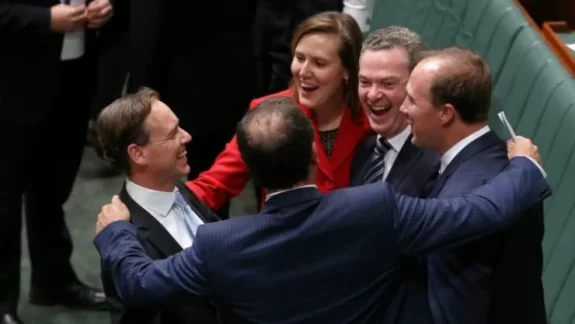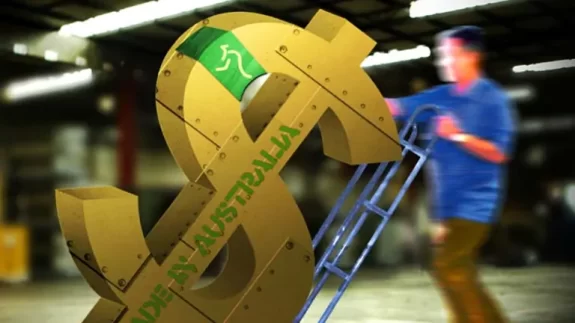Let’s not forget the poor miners …

The high-fiving over the repeal of the carbon tax made me despair at the ignorance of our government – a battle lost but the war continues.
The Abbott government is preparing to axe the mining tax as its repeal bill passed the lower house for a second time on Thursday, with the government limiting debate to under two hours.
The coalition says the mining tax has failed to do its job, raising only $340 million since its introduction. Parliamentary secretary to the minister for finance Michael McCormack also said the tax undermined confidence in Australia as an investment destination and its reputation as resource supplier, which raises the obvious question asked by Chris Bowen, “If it doesn’t raise enough money, then how does it damage the mining industry?”
The total revenue in 2012 for BHP Billiton, Rio Tinto, Woodside Petroleum, Newcrest and Xstrata was A$167.23 billion. Add to that the revenues of the self-defined “small” miners. Gina Rinehart’s Hancock Prospecting alone made a $1.2 billion net profit in 2012. It is projected that in the next decade they will make at least another $600 billion.
State governments will hand over $17.6 billion in mining subsidies over the next four years. The federal government will contribute $4.5 billion a year. That’s $36 billion over the next four years given to companies who are making superprofits from mining our limited resources. That would pay for a real NBN, or high-speed rail, or all the programs that have been slashed by the Coalition and then some.
We are told we must encourage investment by mining companies because they underpin our economy. And yet the facts do not bear this out.
Take Glencore for example, our third largest mining company, who, according to an article in the SMH, paid no tax on the $15 billion profit they made over the last three years. To achieve this they employed aggressive tax avoidance measures, borrowing money at 9% and then relending it in interest free loans. Their profits largely go offshore to foreign shareholders.
”The truth is that Glencore Coal Investments Australia’s operations in Australia are, because of the Group’s business model, branch operations of the Swiss-domiciled parent entity, which uses the now dormant legal shell of an Australian body corporate in an attempt to hide the reality of its branch business in Australia.”
The company disputes this, saying it has paid approximately $3.4 billion in taxes and royalties in Australia over the last three years. Even if this is true, it’s a damn fine return for selling something you don’t own. I wonder how much it has received in subsidies during that time.
Mining companies are also unreliable employers. They quickly sack employees, often on the basis of what the resource market is doing, because profit is paramount.
In March the Australian reported:
“Glencore’s Ravensworth underground operation will be the first coal mine suspended by the Switzerland-based resources titan due to the sharp slide in prices for the fuel, although this follows hundreds of job cuts over the past year as the company looked to bolster the profitability of its sites.”
Followed by this in the Courier Mail last month:
“SWISS mining giant Glencore will shut its Newlands underground coal mine in central Queensland with the loss of 50 jobs next month, but eventually 196 jobs when production ceases next year.
Last year about 450 workers were axed from Newlands and Oaky Creek as the company restructured.”
Over the past two years, coal producers have slashed 12,000 jobs – more than 1,500 destroyed in the Hunter Valley and 8,000 in Queensland – with impunity.
Glencore’s Peter Freyberg claimed that the industry “isn’t as competitive as it should be,” and warned that “productivity, industrial relations and regulatory settings were factors impacting the industry’s competitiveness.”
The mining companies want the ability to hire and fire at will and “flexibility” to make instantaneous changes to work practices, such as shift rosters and the use of contract labour, to meet shifting production demands.
In February, the Abbott government quietly reopened a visa loophole that will allow employers to hire an unlimited number of foreign workers under a temporary working visa, in a move that unions say will bring back widespread rorting of the system.
Before the loophole was closed in 2013 by the Labor government, companies in the mining, construction and IT industries were knowingly hiring hundreds more foreign workers than they had applied for.
In one example, an employer was granted approval for 100 visas over three years, but in 18 months he had brought in 800 workers under the 457 visa.
In the Coalition’s bid to remove all ”red tape” from the 457 skilled migrant visa, employers will not be penalised or scrutinised if they hire more foreign staff than they applied for.
Before the cap was introduced in 2013, the number of 457 visas was quickly rising. In the financial year 2009/10 there were 67,980 visas granted. By 2012/13 there were 126,350 visas granted, statistics from the Department of Immigration show.
The Coalition has put together a panel to review 457 visas. In typical fashion, they have changed the rules before the panel has done its review though, considering the panel members, its recommendations will probably be in line with whatever the business sector wants. There are four members on the panel: John Azarias, from Deloitte Australia; Professor Peter McDonald, of the Australian National University; Katie Malyon, from Ernst & Young; and Jenny Lambert, from the Australian Chamber of Commerce and Industry.
FIFO work arrangements, meant for special circumstances such as geographical isolation, are now increasingly becoming the order of the day.
Gone are the days when companies invested in social infrastructure such as housing, schools and hospitals to make mining towns liveable. These days more than 100,000 workers spend up to 5 weeks at a time away from their families. FIFO workers report high levels of stress and there is a high level of turnover; one out of three FIFO workers will not last more than a year on the job. And for those who do find themselves living in mining towns, the pressure on local transport, housing and hospitals is creating significant social problems.
Following their A$22 million scaremongering TV ad campaign, the revamped Mining Resources Rent Tax (MRRT) now only applies to 22.5 per cent of the mining magnates’ profits, after a questionable “extraction allowance”. And that 22.5 per cent only applies only on coal and iron ore and only on companies that make over $50m in profit.
The Greens asked the PBO to calculate how much could be raised from increasing the tax rate to 40 per cent, plugging loopholes and including all minerals that make super profits, such as gold.
The office said these measures would raise $26.2 billion in the years to 2016/17.
PEFO anticipated $4.4 billion in revenue would be collected from the watered-down mining tax over the forward estimates. MYEFO cut that to $3.4 billion. The Coalition intend to give up this revenue at the expense of the following spending commitments:
- Abolishing the low-income superannuation contribution, with an estimated saving of $3.8 billion. This policy required the Commonwealth Government pay up to $500 a year to the superannuation accounts of certain low-income earners.
- Unwinding the instant asset write-off for small business with a $5,000 threshold, saving $2.3 billion. This policy allowed small businesses to write off depreciating assets costing less than $6,500, and the first $5,000 was offset against the mining tax.
- Slowing the superannuation guarantee increase so it remains fixed at 9.25 per cent until 2016–17 before increasing incrementally to reach 12 per cent by 2021–22. Estimated saving $1.6 billion.
- Discontinuing the company loss carry-back, a benefit for small businesses, saving $950 million.
- Dismantling the accelerated depreciation for motor vehicles, saving $450 million.
- Ending geothermal exploration treatment, saving $10 million.
- Scrapping the Income Support Bonus, which includes payments to the children of veterans and is a lump-sum supplementary payment made twice a year to people on certain income support payment. Estimated saving $1.1 billion.
- Abolishing the Schoolkids Bonus, a lump-sum payment to parents of school-aged children twice a year. It is the largest single savings measure in the repeal bill, estimated at over $5.2 billion, even though the Schoolkids Bonus was not from the mining tax, but an alternative payment which replaced the previous Education Tax refund.
Why we are encouraging people to come and dig up our finite resources with foreign workers to send the profits overseas, subsidising them to do so, eliminating environmental safeguards and workplace conditions, and then repealing a small tax on their superprofits, is absolutely beyond me. And as can be seen by the above list, it is largely middle- and low-income earners and small businesses who will pay for this largesse shown to the mining companies who rape our nation to fill their shareholders’ purses.
Life according to the Coalition.
Like what we do at The AIMN?
You’ll like it even more knowing that your donation will help us to keep up the good fight.
Chuck in a few bucks and see just how far it goes!
Your contribution to help with the running costs of this site will be gratefully accepted.
You can donate through PayPal or credit card via the button below, or donate via bank transfer: BSB: 062500; A/c no: 10495969












